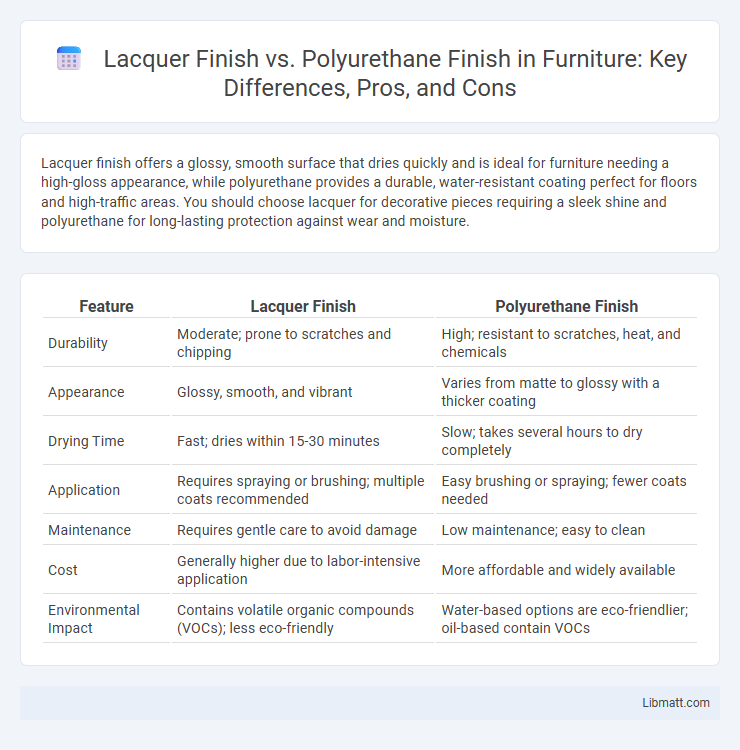Lacquer finish offers a glossy, smooth surface that dries quickly and is ideal for furniture needing a high-gloss appearance, while polyurethane provides a durable, water-resistant coating perfect for floors and high-traffic areas. You should choose lacquer for decorative pieces requiring a sleek shine and polyurethane for long-lasting protection against wear and moisture.
Table of Comparison
| Feature | Lacquer Finish | Polyurethane Finish |
|---|---|---|
| Durability | Moderate; prone to scratches and chipping | High; resistant to scratches, heat, and chemicals |
| Appearance | Glossy, smooth, and vibrant | Varies from matte to glossy with a thicker coating |
| Drying Time | Fast; dries within 15-30 minutes | Slow; takes several hours to dry completely |
| Application | Requires spraying or brushing; multiple coats recommended | Easy brushing or spraying; fewer coats needed |
| Maintenance | Requires gentle care to avoid damage | Low maintenance; easy to clean |
| Cost | Generally higher due to labor-intensive application | More affordable and widely available |
| Environmental Impact | Contains volatile organic compounds (VOCs); less eco-friendly | Water-based options are eco-friendlier; oil-based contain VOCs |
Introduction to Lacquer and Polyurethane Finishes
Lacquer finish is a fast-drying, solvent-based coating known for its high-gloss shine and smooth texture, often used on wood furniture and musical instruments to enhance aesthetic appeal. Polyurethane finish, available in oil-based and water-based formulations, provides a durable, protective layer resistant to scratches, heat, and chemicals, commonly applied on floors, cabinets, and tabletops. Both finishes serve to protect surfaces but differ significantly in application, drying time, and durability.
Composition and Application Methods
Lacquer finish consists of cellulose or synthetic resin dissolved in solvents, applied through spraying or brushing for a quick-drying, smooth surface. Polyurethane finish is a durable polymer-based coating, often applied with a brush or roller, creating a hard, protective layer resistant to scratches and moisture. Your choice depends on desired durability and ease of application, with lacquer favoring faster drying and polyurethane offering tough, long-lasting protection.
Durability and Protection
Lacquer finishes offer a high-gloss, quick-drying surface but tend to be less durable and more prone to scratches and water damage compared to polyurethane finishes. Polyurethane provides superior protection with its thick, hard coating that resists abrasion, heat, and chemicals, making it ideal for high-traffic or frequently used surfaces. For long-lasting durability and enhanced surface protection, polyurethane finishes outperform lacquer in maintaining wood integrity over time.
Appearance and Aesthetic Qualities
Lacquer finish offers a high-gloss, smooth surface with a rich depth that enhances wood grain, providing a classic, polished aesthetic ideal for fine furniture and cabinetry. Polyurethane finish, available in gloss, semi-gloss, and satin, creates a durable, thicker coating that can slightly darken wood and emphasizes texture with a more plastic-like appearance. Lacquer dries faster and can be buffed to a mirror shine, while polyurethane provides a robust, water-resistant layer suited for high-traffic areas without compromising clarity.
Drying and Curing Times
Lacquer finish typically dries within 15 to 30 minutes, allowing rapid recoating and faster overall project completion. Polyurethane finish requires a longer drying period of 4 to 6 hours and can take up to 30 days to fully cure, resulting in a more durable and resistant surface. Understanding these drying and curing times is crucial for selecting the appropriate finish based on project timelines and desired durability.
Maintenance and Repair Considerations
Lacquer finish requires frequent maintenance due to its susceptibility to scratches and moisture damage, making it easier to repair through simple sanding and reapplying lacquer without significant surface disruption. Polyurethane finish offers higher durability and water resistance, necessitating less frequent maintenance but complicating repairs, as damaged areas often require complete refinishing or careful blending to maintain a uniform appearance. Choosing between lacquer and polyurethane finishes depends on the desired balance between ease of repair and long-term maintenance demands.
Cost Comparison
Lacquer finish generally costs less initially due to lower material prices and faster drying times, which reduce labor expenses. Polyurethane finish, while often more expensive upfront, offers greater durability and longer-lasting protection that can decrease maintenance and refinishing costs over time. Evaluating total cost of ownership, polyurethane may provide better value despite higher initial investment.
Environmental Impact and Safety
Lacquer finish typically contains higher levels of volatile organic compounds (VOCs), posing greater environmental and health risks compared to polyurethane finishes, which often offer low-VOC or water-based options. Choosing polyurethane can reduce harmful emissions and improve indoor air quality, making it a safer choice for your workspace and the environment. Proper ventilation and protective gear remain essential regardless of the finish to minimize exposure to potentially toxic fumes.
Best Uses and Recommended Projects
Lacquer finish offers a fast-drying, high-gloss surface ideal for fine furniture, cabinetry, and decorative woodwork requiring a smooth, polished look. Polyurethane finish provides durable, water-resistant protection suited for high-traffic areas, flooring, and outdoor projects exposed to moisture and wear. Choose lacquer for intricate indoor pieces demanding aesthetic appeal, and polyurethane for surfaces needing robust, long-lasting defense.
Choosing the Right Finish for Your Needs
Lacquer finish offers a smooth, glossy surface that dries quickly and is ideal for furniture needing a refined, elegant look, while polyurethane finish provides superior durability and resistance to water, heat, and wear, making it perfect for high-traffic areas. Your choice hinges on balancing aesthetic preference with practical durability requirements, as lacquer enhances visual appeal but polyurethane ensures long-lasting protection. Consider the environment and usage of the furniture to select the finish that aligns best with your maintenance expectations and style goals.
Lacquer finish vs polyurethane finish Infographic

 libmatt.com
libmatt.com